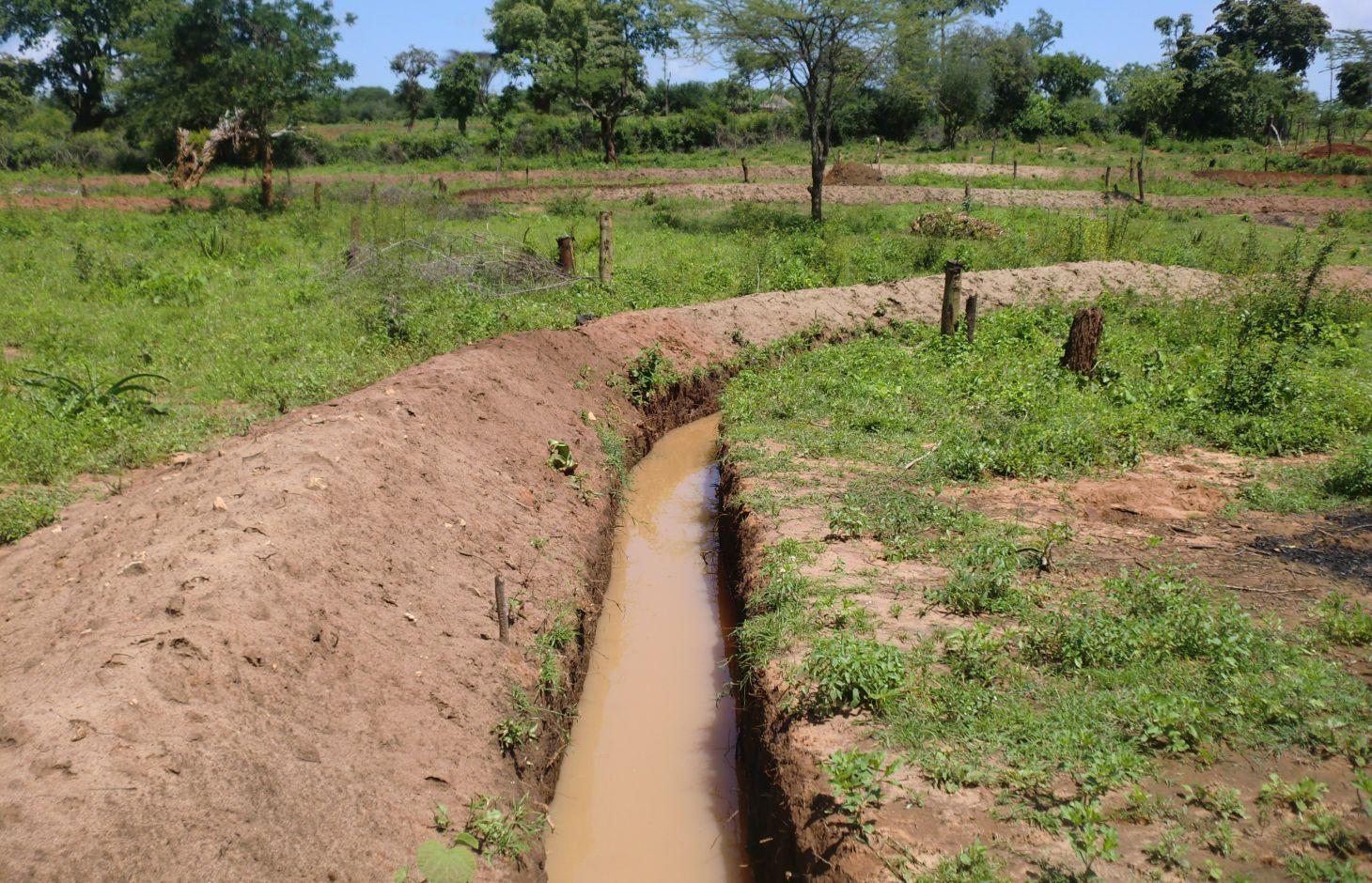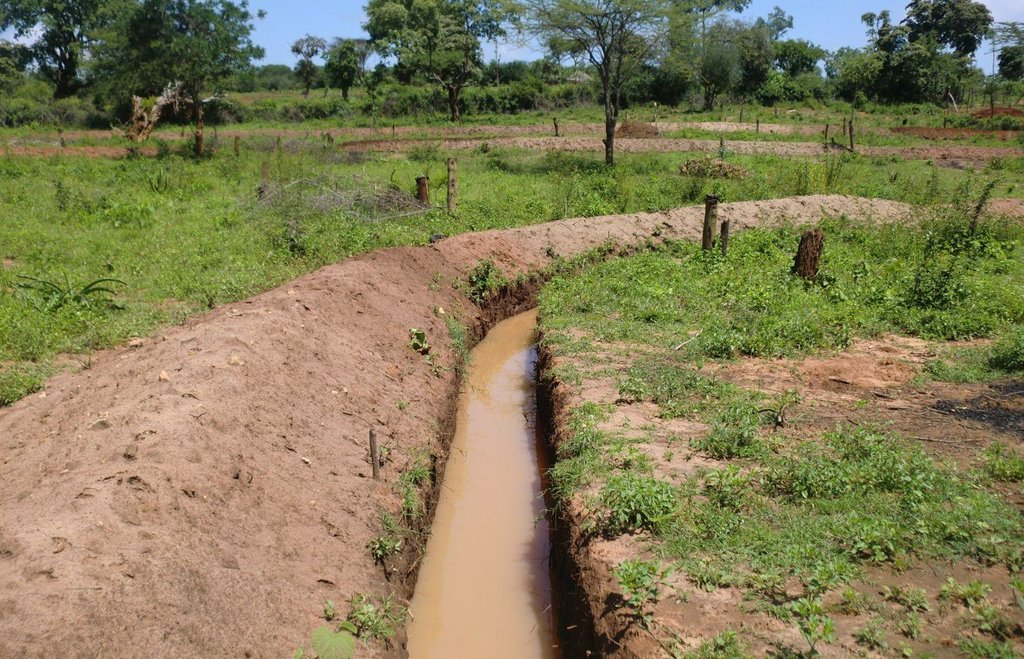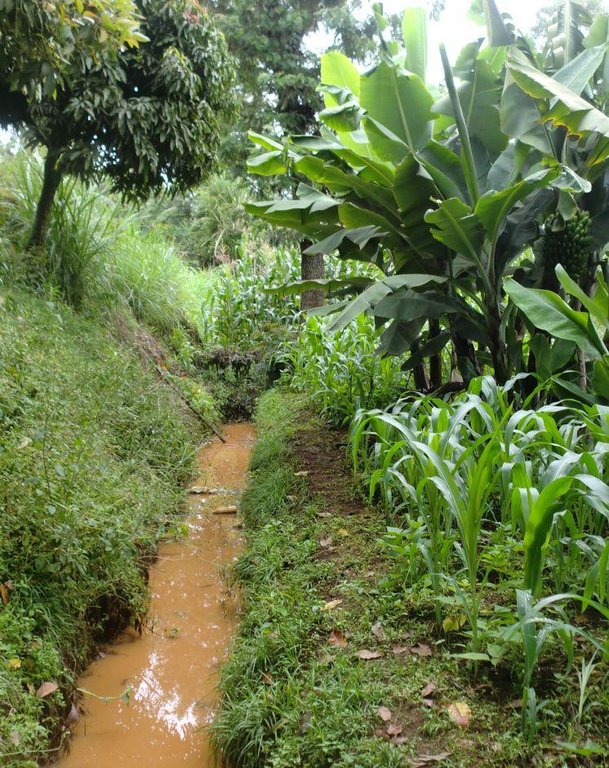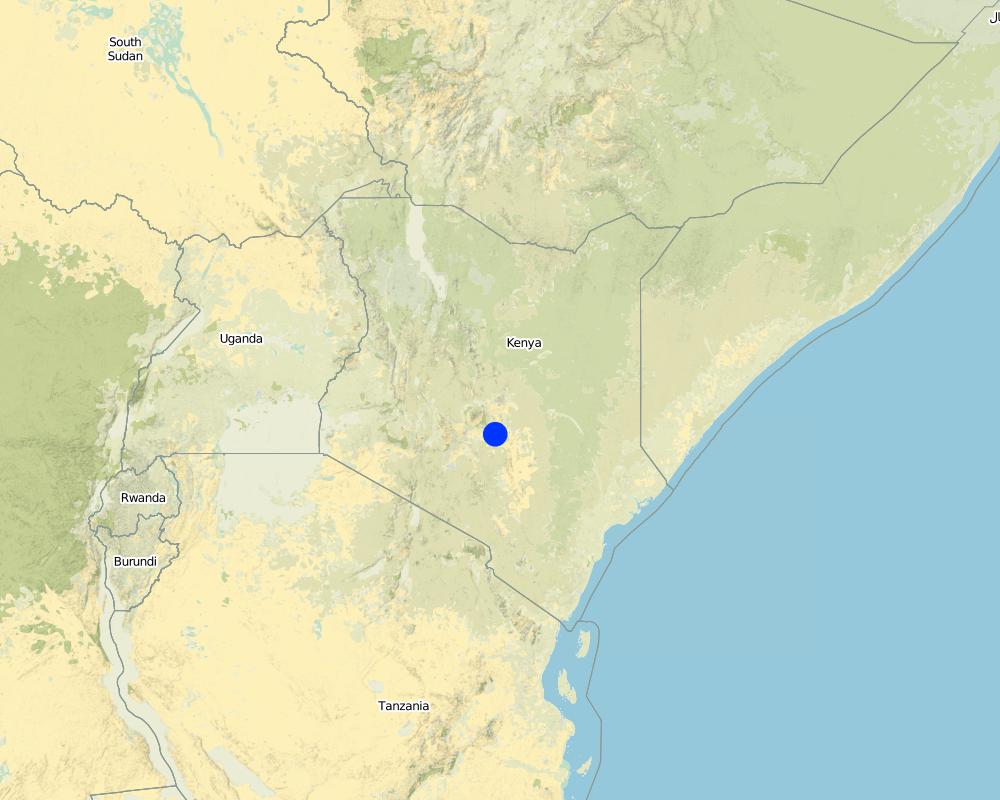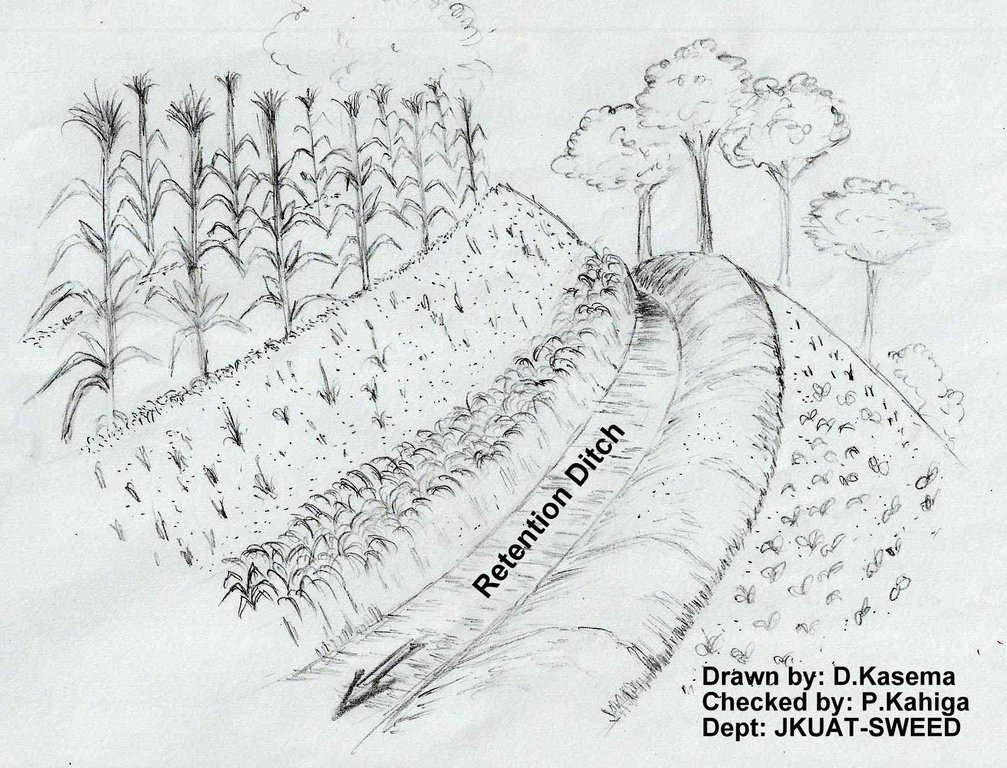Retention ditches [肯尼亚]
- 创建:
- 更新:
- 编制者: Paul Kahiga
- 编辑者: –
- 审查者: Fabian Ottiger, Alexandra Gavilano
Mitaro ya ruji (Mbeere)
technologies_1244 - 肯尼亚
查看章节
全部展开 全部收起1. 一般信息
1.2 参与该技术评估和文件编制的资源人员和机构的联系方式
SLM专业人员:
Gathenya Mwangi
Jomo Kenyatta University of Agriculture and Technology
肯尼亚
SLM专业人员:
Home Patrick
Jomo Kenyatta University of Agriculture and Technology
肯尼亚
SLM专业人员:
Chege Timothy
Jomo Kenyatta University of Agriculture and Technology
肯尼亚
SLM专业人员:
Omwange Abamba
Jomo Kenyatta University of Agriculture and Technology
肯尼亚
SLM专业人员:
Kimengich Baobab
Jomo Kenyatta University of Agriculture and Technology
肯尼亚
SLM专业人员:
Wamuongo Jane
Kenya Agricultural Research Institute
肯尼亚
SLM专业人员:
Karanja Andrew
Kenya Agricultural Research Institute
肯尼亚
SLM专业人员:
Namirembe Sara
World Agroforestry Centre
肯尼亚
有助于对技术进行记录/评估的机构名称(如相关)
International Centre for Research in Agroforestry (ICRAF) - 肯尼亚有助于对技术进行记录/评估的机构名称(如相关)
KARI Headquarters (KARI Headquarters) - 肯尼亚有助于对技术进行记录/评估的机构名称(如相关)
Jomo Kenyatta University (Jomo Kenyatta University) - 肯尼亚1.3 关于使用通过WOCAT记录的数据的条件
编制者和关键资源人员接受有关使用通过WOCAT记录数据的条件。:
是
1.4 所述技术的可持续性声明
这里所描述的技术在土地退化方面是否存在问题,导致无法被认为是一种可持续的土地管理技术?:
否
2. SLM技术的说明
2.1 技术简介
技术定义:
Retention ditches, also called infiltration ditches, are larger ditches designed to catch and retain all incoming runoff for infiltration into the soil.
2.2 技术的详细说明
说明:
Retention ditches, also called infiltration ditches, are larger ditches designed to catch and retain all incoming runoff for infiltration into the soil. They operate like contour furrows, increasing the supply of water made available to crops planted in and adjacent the ditch, while also reducing soil erosion. However, they handle much more water. Retention ditches are in essence water harvesting and conservation structures
Purpose of the Technology: They are commonly used as an alternative to diversion ditches if there is no places to discharge runoff or if there is a need , as in semi –arid areas , to harvest water , e.g. for bananas.
Establishment / maintenance activities and inputs: When constructing the ditches, the soil is thrown to the lower side to form an embankment that prevents soil from falling back in. This structure can be stabilized further by planting grass on it. On soils with lower infiltration rate, or on slopes, the ends can be left open to allow excess water to drain out.
Natural / human environment: Retention ditches are normally constructed on relatively flat areas with closed ends and wide and deep enough to hold all the runoff expected. They are often found on steep slopes in humid area under small scale farming where there is no opportunity to discharge runoff to a waterway. Retentions ditches can be useful where soils are permeable, deep and stable. However, retention ditches are not recommended for areas with shallow soil, those prone to land slides or where soil salinity is a possibility.
2.3 技术照片
2.5 已应用该技术的、本评估所涵盖的国家/地区/地点
国家:
肯尼亚
区域/州/省:
Eastern
有关地点的进一步说明:
Mbeere
具体说明该技术的分布:
- 均匀地分布在一个区域
如果不知道精确的区域,请注明大致覆盖的区域:
- < 0.1 平方千米(10 公顷)
注释:
Retention ditches technology not practiced by many farmers although some collaborate with the local agricultural extension officer from the ministry of Agriculture to show them the guidelines of construction.
Map
×2.6 实施日期
如果不知道确切的年份,请说明大概的日期:
- 10-50年前
2.7 技术介绍
详细说明该技术是如何引入的:
- 通过土地使用者的创新
3. SLM技术的分类
3.1 该技术的主要目的
- 改良生产
- 减少、预防、恢复土地退化
- 创造有益的经济影响
3.2 应用该技术的当前土地利用类型

农田
- 一年一作
- 多年一作(非木材)
多年生(非木质)作物 - 指定作物:
- 香蕉/芭蕉/蕉麻
注释:
Major land use problems (compiler’s opinion): To reduce soil erosion and retain runoff for infiltration.
Major land use problems (land users’ perception): Inadequate water for irrigating the farm.
Future (final) land use (after implementation of SLM Technology): Cropland: Ca: Annual cropping
3.3 由于技术的实施,土地使用是否发生了变化?
由于技术的实施,土地使用是否发生了变化?:
- 否(继续问题3.4)
3.4 供水
该技术所应用土地的供水:
- 混合雨水灌溉
3.5 该技术所属的SLM组
- 集水
- 灌溉管理(包括供水、排水)
- 引水和排水
3.6 包含该技术的可持续土地管理措施

结构措施
- S4:平沟、坑
3.7 该技术强调的主要土地退化类型

水质恶化
- Hs:地表水良变化
注释:
Main causes of degradation: soil management, Heavy / extreme rainfall (intensity/amounts), poverty / wealth, labour availability
Secondary causes of degradation: deforestation / removal of natural vegetation (incl. forest fires)
3.8 防止、减少或恢复土地退化
具体数量名该技术与土地退化有关的目标:
- 防止土地退化
- 修复/恢复严重退化的土地
4. 技术规范、实施活动、投入和成本
4.1 该技术的技术图纸
技术规范(与技术图纸相关):
A technical drawing showing a retention ditch. The run-off ponds within the ditch giving it time to infiltrate.
Location: Ntharawe. Eastern Province
Date: 27/10/2012
Technical knowledge required for field staff / advisors: moderate (In implement this technology the farmers collaborates with an Agriculture extension officer in order to assist in making the retention ditches.)
Technical knowledge required for land users: low (Water scarcity triggers farmers to look for better means of soil conservation and retention ditch plays an important role to satisfy crop water requirement.)
Main technical functions: control of concentrated runoff: retain / trap, increase of infiltration
Secondary technical functions: control of concentrated runoff: impede / retard, reduction of slope angle
Retention/infiltration ditch/pit, sediment/sand trap
Vertical interval between structures (m): 6
Spacing between structures (m): 30
Depth of ditches/pits/dams (m): 0.5
Width of ditches/pits/dams (m): 0.5
Length of ditches/pits/dams (m): 50
Height of bunds/banks/others (m): 0.5
Width of bunds/banks/others (m): 0.5
Length of bunds/banks/others (m): 50
作者:
Paul Kahiga, 8444-00300 Nairobi
4.2 有关投入和成本计算的一般信息
其它/国家货币(具体说明):
Kshs
如相关,注明美元与当地货币的汇率(例如1美元=79.9巴西雷亚尔):1美元=:
100.0
注明雇用劳工的每日平均工资成本:
5.00
4.3 技术建立活动
| 活动 | 时间(季度) | |
|---|---|---|
| 1. | Clearing of vegetation | before the rain starts |
| 2. | Marking contours | After vegetation clearance |
| 3. | Digging the ditches | after marking the contours |
4.4 技术建立所需要的费用和投入
| 对投入进行具体说明 | 单位 | 数量 | 单位成本 | 每项投入的总成本 | 土地使用者承担的成本% | |
|---|---|---|---|---|---|---|
| 劳动力 | Labour | ha | 1.0 | 80.0 | 80.0 | 100.0 |
| 设备 | Tools | ha | 1.0 | 50.0 | 50.0 | 100.0 |
| 技术建立所需总成本 | 130.0 | |||||
| 技术建立总成本,美元 | 1.3 | |||||
4.5 维护/经常性活动
| 活动 | 时间/频率 | |
|---|---|---|
| 1. | Removal of excess sediments | once after rainy season |
4.6 维护/经常性活动所需要的费用和投入(每年)
| 对投入进行具体说明 | 单位 | 数量 | 单位成本 | 每项投入的总成本 | 土地使用者承担的成本% | |
|---|---|---|---|---|---|---|
| 劳动力 | Labour | ha | 1.0 | 45.0 | 45.0 | 100.0 |
| 设备 | Tools | ha | 1.0 | 35.0 | 35.0 | 100.0 |
| 技术维护所需总成本 | 80.0 | |||||
| 技术维护总成本,美元 | 0.8 | |||||
注释:
in the month of June 2012
4.7 影响成本的最重要因素
描述影响成本的最决定性因素:
slope of the land, labour and availability of a technical person to assist in laying down of the contours
5. 自然和人文环境
5.1 气候
年降雨量
- < 250毫米
- 251-500毫米
- 501-750毫米
- 751-1,000毫米
- 1,001-1,500毫米
- 1,501-2,000毫米
- 2,001-3,000毫米
- 3,001-4,000毫米
- > 4,000毫米
农业气候带
- 半干旱
Thermal climate class: tropics
5.2 地形
平均坡度:
- 水平(0-2%)
- 缓降(3-5%)
- 平缓(6-10%)
- 滚坡(11-15%)
- 崎岖(16-30%)
- 陡峭(31-60%)
- 非常陡峭(>60%)
地形:
- 高原/平原
- 山脊
- 山坡
- 山地斜坡
- 麓坡
- 谷底
垂直分布带:
- 0-100 m a.s.l.
- 101-500 m a.s.l.
- 501-1,000 m a.s.l.
- 1,001-1,500 m a.s.l.
- 1,501-2,000 m a.s.l.
- 2,001-2,500 m a.s.l.
- 2,501-3,000 m a.s.l.
- 3,001-4,000 m a.s.l.
- > 4,000 m a.s.l.
5.3 土壤
平均土层深度:
- 非常浅(0-20厘米)
- 浅(21-50厘米)
- 中等深度(51-80厘米)
- 深(81-120厘米)
- 非常深(> 120厘米)
土壤质地(表土):
- 中粒(壤土、粉土)
表土有机质:
- 低(<1%)
如有可能,附上完整的土壤描述或具体说明可用的信息,例如土壤类型、土壤酸碱度、阳离子交换能力、氮、盐度等。:
Soil fertility: Medium
Soil drainage/infiltration: Medium
Soil water storage capacity: Medium
5.4 水资源可用性和质量
地下水位表:
5-50米
地表水的可用性:
中等
水质(未处理):
不良饮用水(需要处理)
5.5 生物多样性
物种多样性:
- 中等
5.6 应用该技术的土地使用者的特征
生产系统的市场定位:
- 混合(生计/商业)
非农收入:
- 低于全部收入的10%
相对财富水平:
- 平均水平
个人或集体:
- 个人/家庭
机械化水平:
- 手工作业
性别:
- 男人
说明土地使用者的其他有关特征:
Land users applying the Technology are mainly common / average land users
Population density: 10-50 persons/km2
Annual population growth: 0.5% - 1%
5.7 应用该技术的土地使用者使用的平均土地面积
- < 0.5 公顷
- 0.5-1 公顷
- 1-2 公顷
- 2-5公顷
- 5-15公顷
- 15-50公顷
- 50-100公顷
- 100-500公顷
- 500-1,000公顷
- 1,000-10,000公顷
- > 10,000公顷
这被认为是小规模、中规模还是大规模的(参照当地实际情况)?:
- 小规模的
5.8 土地所有权、土地使用权和水使用权
土地所有权:
- 个人,有命名
土地使用权:
- 个人
用水权:
- 个人
5.9 进入服务和基础设施的通道
健康:
- 贫瘠
- 适度的
- 好
教育:
- 贫瘠
- 适度的
- 好
6. 影响和结论性说明
6.1 该技术的现场影响
社会经济效应
生产
作物生产
生产故障风险
土地管理
收入和成本
农业收入
社会文化影响
食品安全/自给自足
SLM/土地退化知识
Improved livelihoods and human well-being
生态影响
水循环/径流
水的回收/收集
土壤
土壤水分
生物多样性:植被、动物
害虫/疾病控制
注释/具体说明:
waterborne pests
6.2 该技术的场外影响已经显现
对邻近农田的破坏
6.3 技术对渐变气候以及与气候相关的极端情况/灾害的暴露和敏感性(土地使用者认为的极端情况/灾害)
渐变气候
渐变气候
| 季节 | 增加或减少 | 该技术是如何应对的? | |
|---|---|---|---|
| 年温度 | 增加 | 好 |
气候有关的极端情况(灾害)
气候灾害
| 该技术是如何应对的? | |
|---|---|
| 干旱 | 好 |
注释:
stabilization of the up-slope using grass which is also fed to animals
6.4 成本效益分析
技术收益与技术建立成本相比如何(从土地使用者的角度看)?
短期回报:
积极
长期回报:
积极
技术收益与技术维护成本/经常性成本相比如何(从土地使用者的角度看)?
短期回报:
积极
长期回报:
积极
6.5 技术采用
注释:
There is a moderate trend towards spontaneous adoption of the Technology
6.7 该技术的优点/长处/机会
| 编制者或其他关键资源人员认为的长处/优势/机会 |
|---|
| Retains runoff and improves soil moisture |
| It is a water harvesting technology for crops in dry areas |
| Reduces soil erosion by wind |
6.8 技术的弱点/缺点/风险及其克服方法
| 编制者或其他关键资源人员认为的弱点/缺点/风险 | 如何克服它们? |
|---|---|
| Prevents movement of machinery within the farms | leave some passages that can allow movement of machinery within the farm. |
| The retained water can habour mosquitoes and other water borne pests | Spraying with appropriate insecticides. |
| labour intensive to construct and to maintain | |
| Regular maintenance of the ditches. |
7. 参考和链接
7.1 信息的方法/来源
- 实地考察、实地调查
- 与土地使用者的访谈
(现场)数据是什么时候汇编的?:
19/09/2012
链接和模块
全部展开 全部收起链接
无链接
模块
无模块


